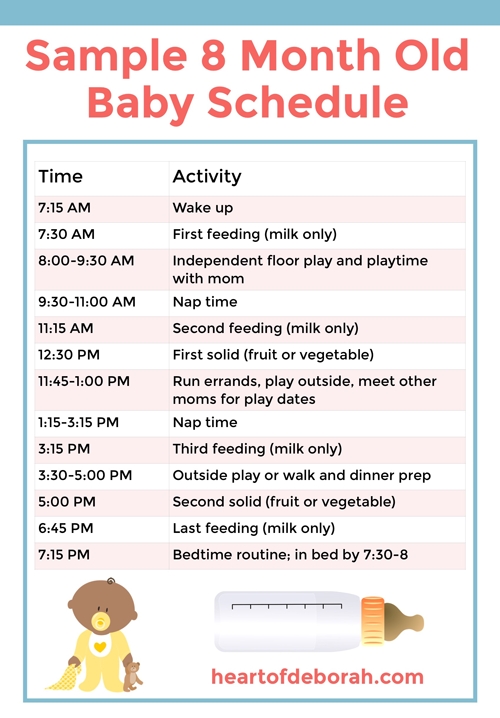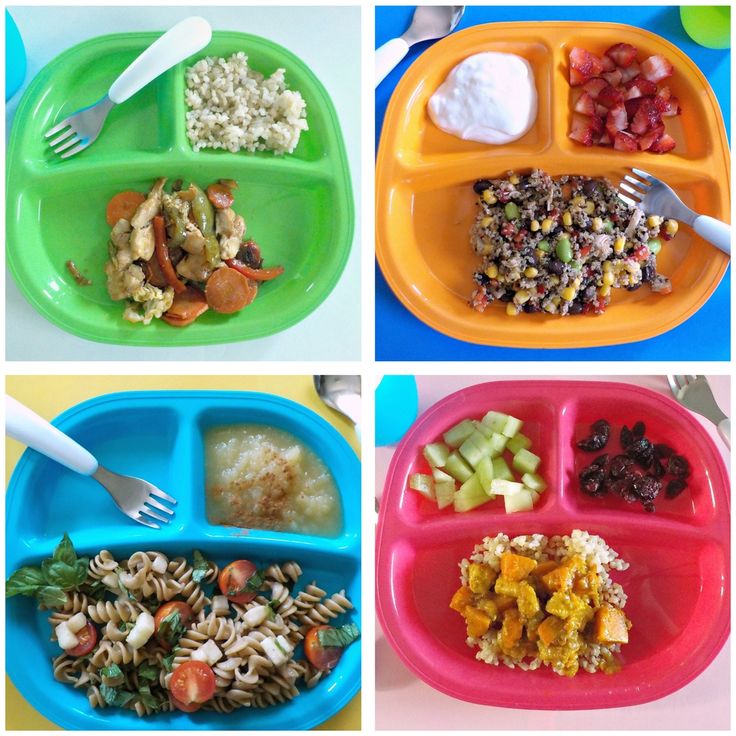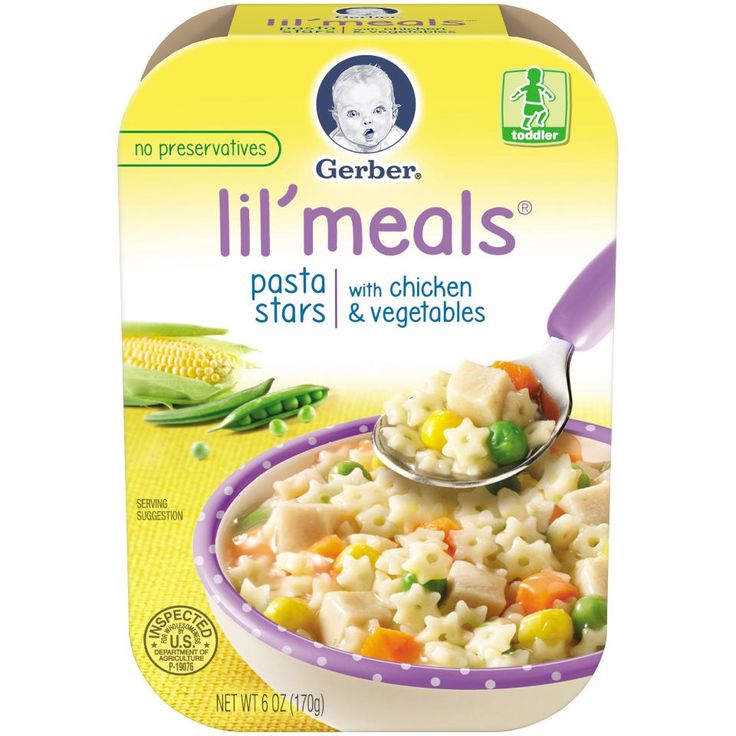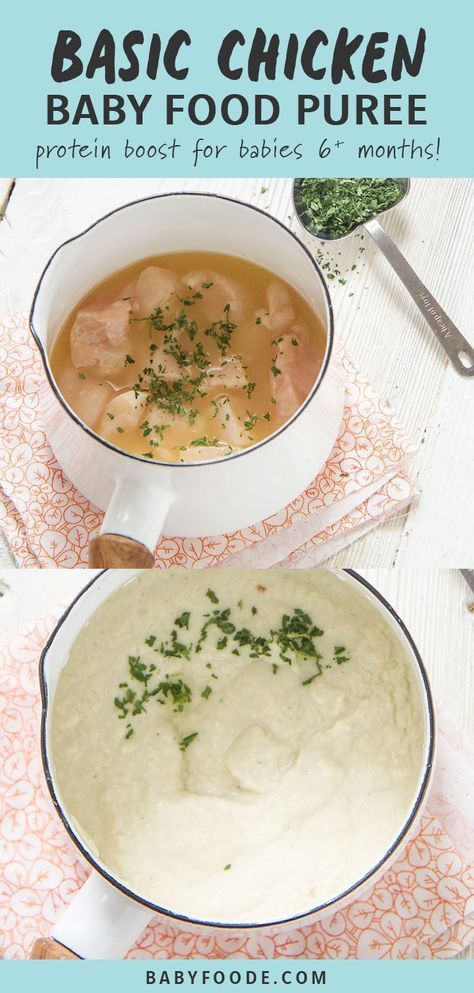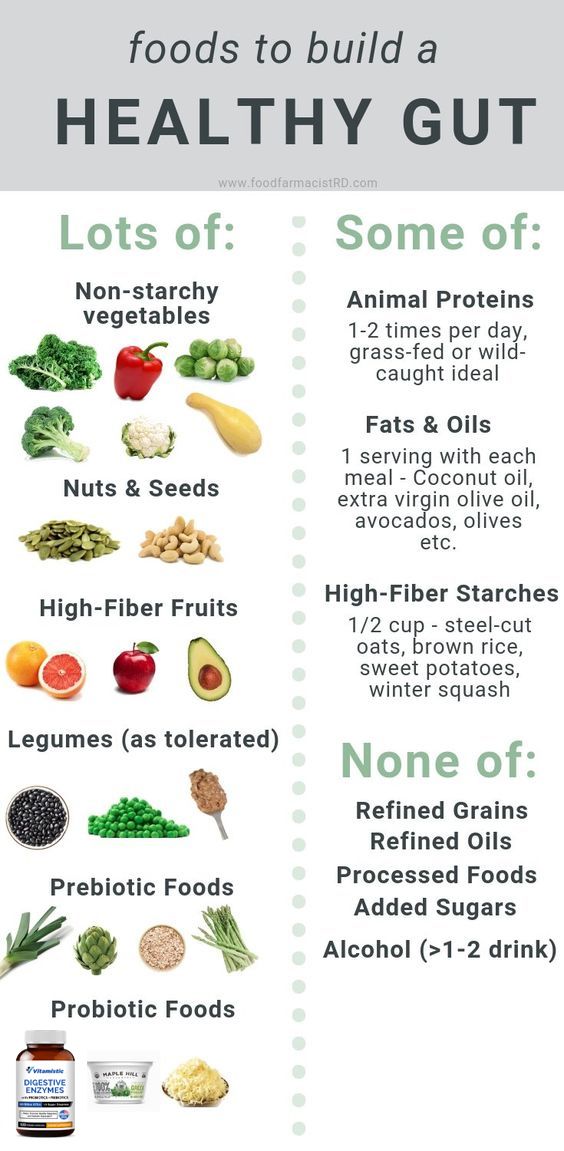Best foods for baby 4 6 months
The Ultimate Guide to Baby’s First Foods from 4-6 Months Old
If you have a baby between 4 and 6 months old, you’re probably starting to think about what their first foods will be…which means you probably have questions about baby’s first foods, too! Things like: “When should I start?” “Do I need to stick to single-ingredient foods?” and “How do I safely introduce common allergens like peanut butter without freaking out?!” Chances are, you miiiiight be a little overwhelmed at the idea of first foods, too. I know it’s a lot to think about, but the good news is that you’ve found your way here! And now that you’re here, I can help.
As a mom of two and a pediatric dietitian, I’m writing this post to help you navigate the nerves and the new chapter that is buying, preparing, and serving up baby’s first foods! Whether you’re going for purees, baby-led weaning, or a combination of both, consider this your ultimate guide to what first foods to serve and how to introduce them to your baby safely.
P.S. Don’t forget to save this post! I know it’s one you’ll want to come back to again and again.
This post contains affiliate links. As an Amazon Associate, I earn from qualifying purchases at no extra cost to you.
Skip right to the first foods info you’re looking for:
- When To Serve Baby Their First Foods
- Safety For Baby’s First Foods
- Purees vs. Baby-Led Weaning: What’s Right For You?
- The Best Foods To Introduce Baby To Between 4 & 6 Months Old
- The Ultimate Baby’s First Foods List
- Best Finger Foods & Baby-Led Weaning First Foods
- The Best Pureed First Foods
- The Best Easy-To-Make First Foods
- The Most Nutritious First Foods
- The Best Vegetarian First Foods
- Foods That Should Be Avoided
- Baby’s First Foods Chart: What, When & How To Serve Common First Foods to 4- to 6-Month-Old Babies
- First Foods For Babies With Allergies
When To Serve Baby Their First Foods
Although some people will serve baby’s first foods earlier, I recommend starting solids closer to the six-month mark.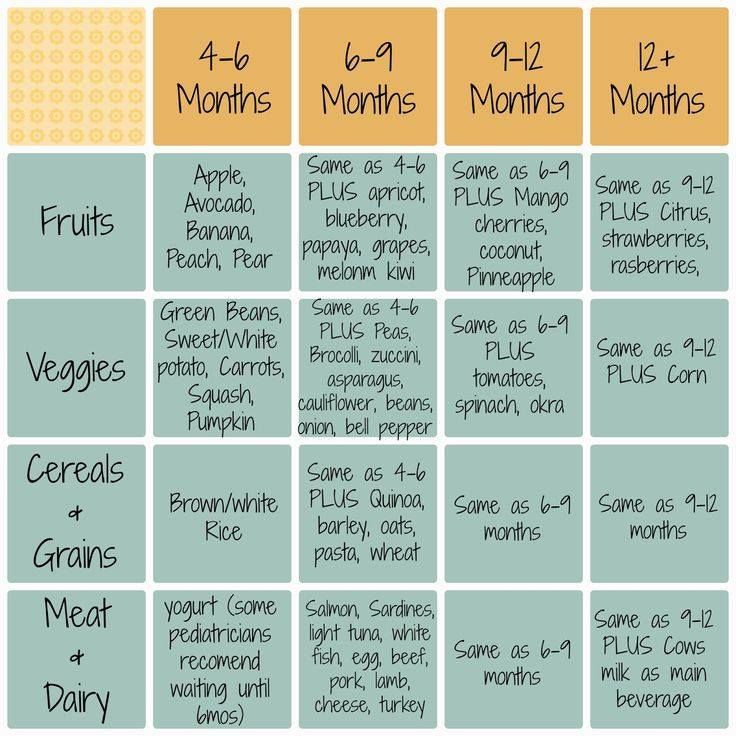 You want to avoid adding rice cereal or any other food to their bottle, and instead, begin solids when they display the signs of readiness listed below. By waiting to serve baby’s first foods until they’re truly ready, you increase their safety and chances of success as a new eater.
You want to avoid adding rice cereal or any other food to their bottle, and instead, begin solids when they display the signs of readiness listed below. By waiting to serve baby’s first foods until they’re truly ready, you increase their safety and chances of success as a new eater.
Signs of Eating Readiness
Your baby is ready to start solids if they:
- Can sit upright
- Can sit unsupported
- Have good head and neck control
- Have some practice bringing toys or objects from their hand to their mouth
- Show an interest in food (By reaching for what you’re eating, intently watching as others eat, etc.)
Can I Give My 4-Month-Old Baby Food?
Some pediatricians may okay solids around four months, but again, I generally recommend waiting until closer to six months, and when baby is displaying those signs of readiness.
There are more benefits to waiting than there are to starting earlier. Before six months, babies get everything they need from breastmilk or formula, so starting solids early won’t help them sleep better, grow faster, or, you know, become a professional athlete!
If you want to get your four- or five-month-old baby involved in mealtime, I recommend getting them acquainted with food and eating in these ways:
- Sit them near you while you’re eating
- Give them a silicone spoon to hold (I like NumNum GooTensils, EZPZ Tiny Spoons, and Olababy Training Spoons) and let them practice bringing it to their mouth
- Give them teething toys, like Sophie, or this elephant, to desensitize the gag reflex
FAQ: Do Formula- and Breast-Fed Babies Have Different Nutritional Needs?
Formula and breast milk are both completely nutritionally satisfactory for the first six months of life and beyond. So when it comes to starting solids, it doesn’t matter whether your baby has been receiving breast milk or formula.
So when it comes to starting solids, it doesn’t matter whether your baby has been receiving breast milk or formula.
That said, babies who are exclusively breastfed should receive a Vitamin D supplement, as levels in breastmilk are low. Formulas on the other hand are typically fortified with Vitamin D, so formula-fed babies don’t need one. Another thing to consider for a baby’s nutrition is iron. Babies build up an iron reserve from their mothers while in utero, but these stores begin to decline around six months of age for all babies.
Safety For Baby’s First Foods
Safety is a huge concern for parents when starting solids. Whether you start with baby foods, purees, or baby-led weaning, there are certain parameters to follow to make sure baby’s intro to food is safe and successful.
Choking Hazards for 4- to 6-Month-Old Babies
Choking hazards for babies ages four to six months old include any foods that are hard, crunchy, sticky, or chewy, as well those that are dangerous shapes.
Common hazardous foods are:
- Chips
- Popcorn
- Pretzels
- Raw Apple
- Globs of Nut Butter
- Hot Dogs
- Grapes
- Large seeds (sunflower, pumpkin, for example)
- Whole nuts
Many of these foods can be prepared safely to minimize the risk of choking, but they remain a choking hazard if they’re in their “natural” states until children turn four years old.
You can minimize choking risks by making sure your child is seated upright and strapped in a high chair with good trunk support. Foot support on a high chair is also helpful when your baby is starting out because it reinforces their stability, and when they’re more stable, they can chew and swallow more safely!
AAP & CDC Recommendations
The Center for Disease Control and Prevention (CDC) and the American Academy of Pediatrics (AAP) recommend starting solids around six months of age, but not before four months. Again, some pediatricians may okay solids around four months of age, but I usually recommend waiting until six months to make sure baby is showing the physical signs of readiness I outlined above.
The one exception may be for introducing certain allergens to certain infants, depending on their inherent level of risk. Speak with your pediatrician or allergist to see if they want to start your baby on certain foods early.
Purees vs. Baby-Led Weaning: What’s Right For You?
Before you serve baby their first foods, you’ll need to decide what kinds of foods you want to offer. And while there’s a lot of dialogue and opinions about the “best” way to feed a baby, I want you to know there isn’t one right way to do this. You can start with purees or baby-led weaning, or you can do a combination of both.
Tip: If you take a puree approach, help them learn to self-feed by offering baby preloaded spoons and letting them bring the food to their mouth.
Babies are very intuitive about getting the nutrition they need, so full permission to opt for the feeding style that’s comfortable for you. They’ll be able to get enough to eat either way! If simple textures feel easier and lower-stress for you, start with purees.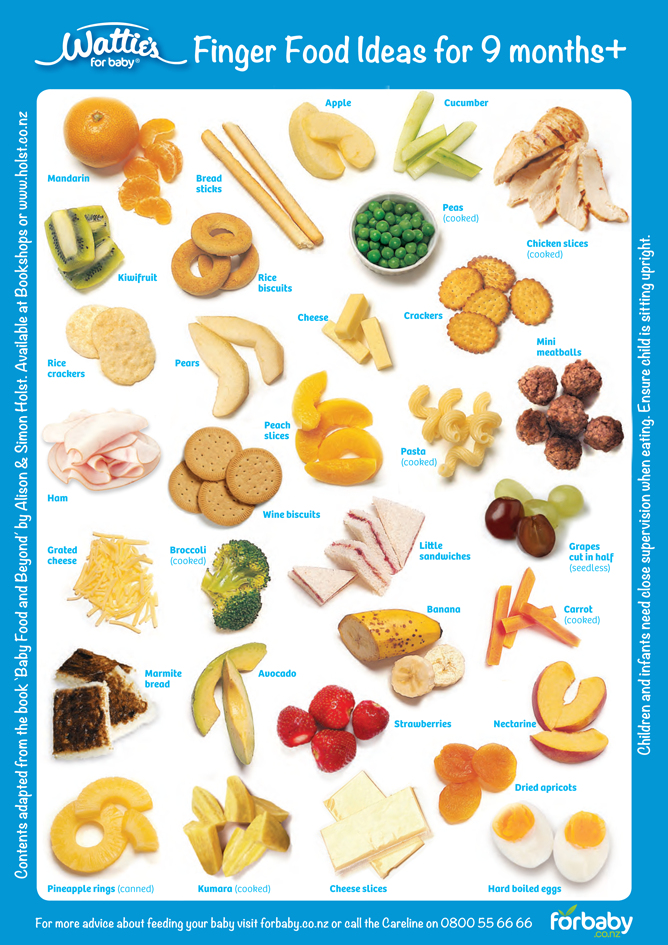 If you’re ready to tackle preparing foods in a way that’s safe for baby, go for baby-led weaning. And if you’re on the go a lot or need a caretaker to feed your baby sometimes, maybe a hybrid approach is best. It truly doesn’t matter as long as you’re helping them foster independence in eating, and offering a variety of different foods.
If you’re ready to tackle preparing foods in a way that’s safe for baby, go for baby-led weaning. And if you’re on the go a lot or need a caretaker to feed your baby sometimes, maybe a hybrid approach is best. It truly doesn’t matter as long as you’re helping them foster independence in eating, and offering a variety of different foods.
One thing that DOES matter when it comes to feeding your baby is letting them be in charge of how much they eat (while you learn to interpret their hunger and fullness cues). And you can do this whether you’re feeding them purees or finger foods.
Baby Signs Of Hunger:
- Reaching for food
- Moving toward the spoon
- Opening their mouth
- Pointing to food
- Excited at the sight of food
Baby Signs Of Fullness:
- Turning away from food
- Batting spoon away
- Clamping mouth shut
- Playing with/throwing food
- Significantly slowed pace of eating
- No longer showing interest
The Best Foods To Introduce Baby To Between 4 & 6 Months Old
A common question I get is, “What baby foods should I introduce first?” And really, there isn’t one “best” first food. You do not have to start with only baby cereal or only veggies or fruits. In fact, you shouldn’t! Research shows that introducing babies to a wide variety of foods early on is what’s most beneficial.
You do not have to start with only baby cereal or only veggies or fruits. In fact, you shouldn’t! Research shows that introducing babies to a wide variety of foods early on is what’s most beneficial.
That said, my favorite first food is avocado! It’s a wonderful source of healthy fat, and it’s loaded with vitamins and minerals. Fat is essential to the developing brain and central nervous system, so we want to prioritize it within a baby’s first foods and make sure it’s completely unrestricted during their first two years of life.
(We also want to prioritize iron, because it’s a common dietary deficiency, and our babies begin to run out of the iron stores they got in utero by about six months.)
It’s Okay If Baby’s First Foods Have Multiple Ingredients!
You may choose to serve solely single-ingredient foods like avocado or sweet potato, but know that it’s not necessary to do so. It can be really helpful to serve a variety of new foods together, so they get used to different tastes and textures.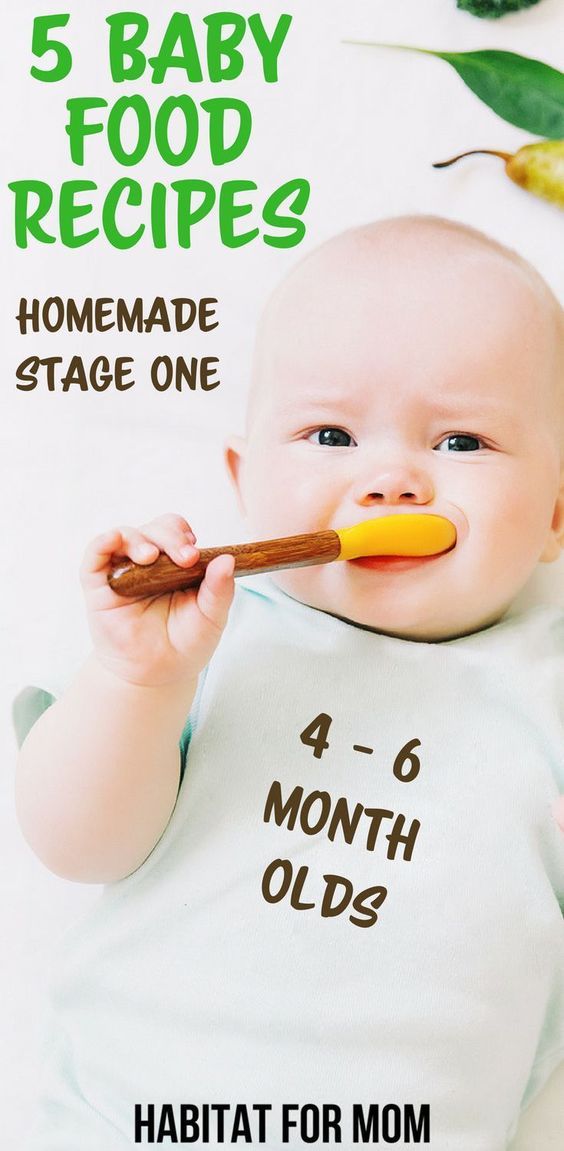 Plus, there are nutritional benefits to mixing foods. For example, yogurt—a common first food for babies—can be fortified with mashed fruit, nut butter, or hemp seeds to up the nutritional value. (But if you ever notice a reaction or suspect an allergy to a component of a food combination you’ve been serving, stop serving the suspected allergen and contact your pediatrician.)
Plus, there are nutritional benefits to mixing foods. For example, yogurt—a common first food for babies—can be fortified with mashed fruit, nut butter, or hemp seeds to up the nutritional value. (But if you ever notice a reaction or suspect an allergy to a component of a food combination you’ve been serving, stop serving the suspected allergen and contact your pediatrician.)
PSA: Skip The Baby Cereal
The recommendations from years past telling parents to start with rice-based infant cereals are outdated now. Rice cereals aren’t super nutritious, and we don’t want to rely too much on rice due to potential exposure to arsenic. So instead of cereals, offer new foods in safely-prepared forms. This is way more nutritious, and it exposes them to different flavors, textures, and nutrients which are beneficial for growth and development and can protect them against food allergies and picky eating.
The Ultimate List of Baby Foods
I’m covering allll the best kinds of baby foods separately, so you get all the juicy info and context you need. Then, I’m combining them all into one big, bad, comprehensive list of the best first foods for baby at the end.
Then, I’m combining them all into one big, bad, comprehensive list of the best first foods for baby at the end.
SKIP TO THE LIST
Best Finger Foods & Baby-Led Weaning First Foods
For baby’s first foods, I like to suggest approachable options like avocado, sweet potato, and banana. These can be prepared and served baby-led-weaning-style by cutting them in wedges or crescent shapes that can be gripped with a palmar grasp. Bananas can be served as halves or in thirds-long ways. Just stick to serving items in longer shapes, about the width of two adult fingers, for the first few months of BLW. This way, baby can hold them and bring them to their mouth. Once your baby is a little bit older—usually around 9 months—many foods can be served safely in smaller pieces.
The Best Pureed First Foods
If you’re going the puree route, you can start with many of the same foods. Just mash up the sweet potato, avocado, banana—or whatever else, really!—and serve those as purees. You may want to thin them some with breastmilk or formula.
You may want to thin them some with breastmilk or formula.
But shortly after starting with these foods, I would move on to introducing allergenic foods, because the early and repeated introduction of allergenic foods can be protective against the development of food allergies in babies, specifically for peanuts. Foods like yogurt and peanut butter may be good early options for allergenic introductions and are already in pureed form. Just start with small amounts.
The Best Easy-To-Make First Foods
Foods that are naturally soft are the easiest to prepare for young eaters. Banana, yogurt, apple sauce, and avocado are all great options that are easy to serve with little to no prep. You can also mix creamy nut butter with yogurt and incorporate other mashed fruits, like raspberries and blackberries, to ramp up the nutritional value while keeping prep extremely low.
Don’t feel like you need to shy away from foods that aren’t naturally soft, either! Many other fruits and veggies, like sweet potato, broccoli, and pears, can also be safely served with simple steaming or roasting techniques.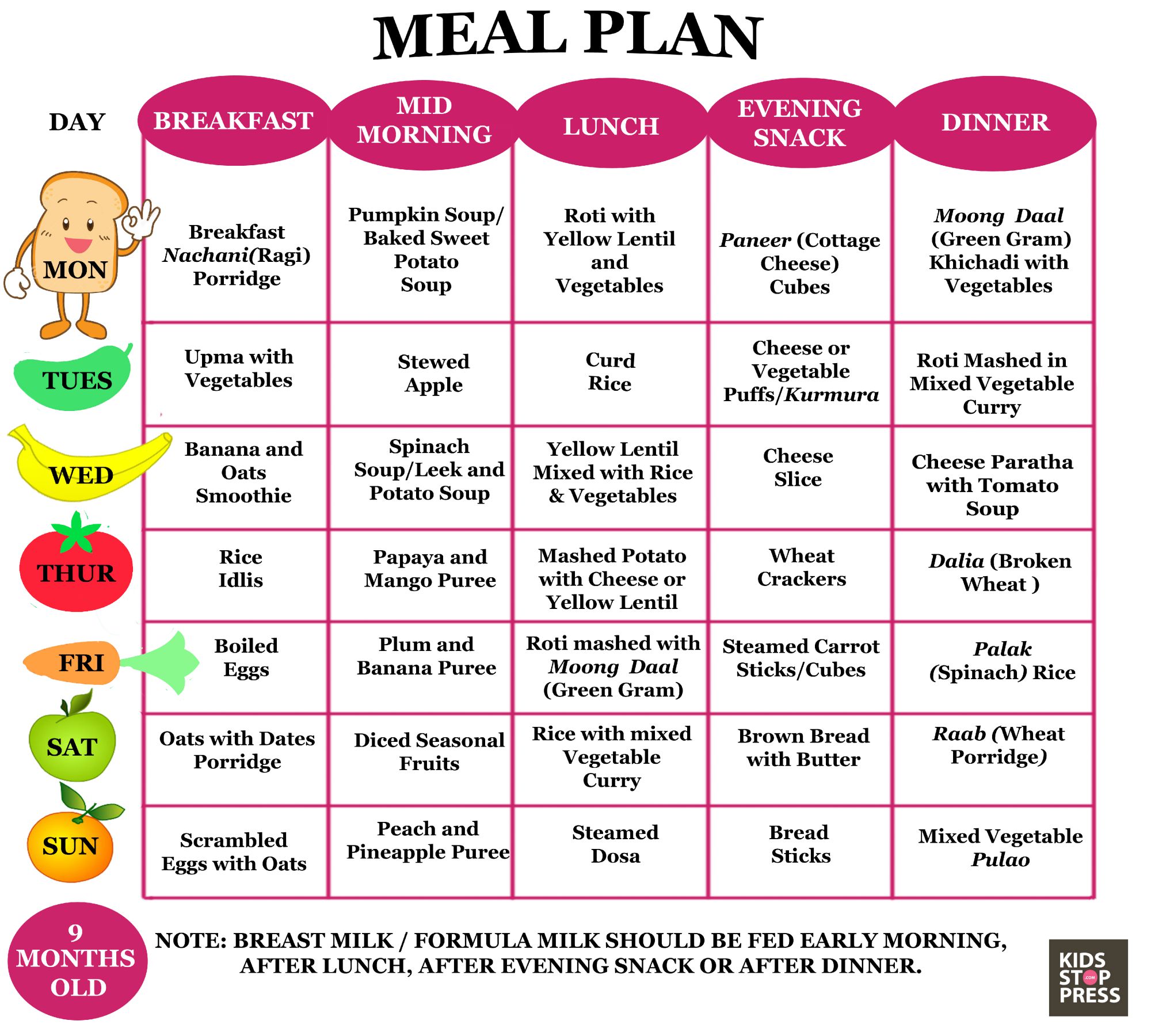 Just make sure to cook these foods until they’re soft enough to be smashed between your fingers, so baby can safely enjoy them, and present them in a shape or style that they can safely navigate. (Soft foods can also be served to them on a pre-loaded spoon if they can’t be eaten by hand, yet.)
Just make sure to cook these foods until they’re soft enough to be smashed between your fingers, so baby can safely enjoy them, and present them in a shape or style that they can safely navigate. (Soft foods can also be served to them on a pre-loaded spoon if they can’t be eaten by hand, yet.)
Low-Prep First Food Options:
- Banana
- Yogurt (Can mix with mashed berries or nut butter)
- Apple Sauce
- Avocado
- Steamed Veggies (Soft enough to mash between your fingers)
The Most Nutritious First Foods
There are so many great, nutrient-dense choices for baby’s first foods that are safe by six months of age no matter what type of foods you serve. (But it’s true that, if you take a baby-led weaning approach, you’ll probably have more options.) Sardines and salmon (fresh or canned) are both loaded with omega-3 fatty acids, DHA, protein, and tons of vitamins and minerals, which make them highly nutritious first foods! From the plant kingdom, sweet potato and avocado are nutrient-dense foods with a wide variety of vitamins and minerals including vitamin A, vitamin B6, vitamin C, and magnesium.
The Best Vegetarian First Foods
Vegetarian foods are some of the best first foods for baby! There are tons of wonderful and nutritious fruit and veggie options that suit young eaters, like berries, bananas, avocados, potatoes, broccoli, squash, and many others. Non-produce vegetarian items are great first foods for baby, too. Think tofu strips, eggs (yolk and white), beans, nut butter, and oatmeal.
Just be sure you serve these in safe shapes and forms, and that they’re soft enough to be mashed between your fingers. Always avoid serving things that are hard, sticky, or chewy, and keep in mind that many raw vegetables and fruits are choking hazards (like celery and apple).
Foods That Should Be Avoided
While most foods have a place in most diets, there are some foods to avoid serving your 4- to 6-month-old baby:
Added Sugar
To make sure our babies get the most nutrition possible during this important phase of growth and development, it’s best to avoid added sugar for children under two. Added sugar doesn’t have much nutritional value, so it’s best to limit it as much as possible and avoid it altogether if possible.
Added sugar doesn’t have much nutritional value, so it’s best to limit it as much as possible and avoid it altogether if possible.
Want to offer baby fun, homemade foods like cookies, bars, and muffins once they are fully established on solids? You still can! Just use the recipes in my No Sugar, Still Sweet cookbook, where everything is sweetened with fruit alone.
Honey
Babies should strictly avoid honey before 12 months of age. Honey can be contaminated with spores of a bacteria called clostridium botulinum. In babies under one, these spores can multiply and produce a dangerous toxin that causes infant botulism.
Related: Honey for Babies & Toddlers
Sodium
Finally, sodium should be limited. For babies ages four to six months, the recommended sodium limit intake for a day is 110 mg, which includes any sodium present in breast milk and/or formula.
Fruit Juice
The American Academy of Pediatrics recommends no fruit juice before 1 year of age. Juice offers very few nutritional benefits and therefore isn’t a helpful addition to a baby’s diet.
Juice offers very few nutritional benefits and therefore isn’t a helpful addition to a baby’s diet.
- Under 1: No Juice
- Age 1-3: 4 Oz Daily Max
- Age 4-6: 4-6 Oz Daily Max
- Age 7-18: 8 Oz Daily Max
The Ultimate Baby’s First Foods List
- Avocado
- Sweet Potato (Mashed or Steamed)
- Broccoli (Steamed or Roasted)
- Pears (Steamed or Roasted)
- Butternut Squash
- Mango
- Banana
- Yogurt*
- Nut Butter* (Mixed-In To Purees or Spread Thin on Toast)
- Oatmeal
- Apple Sauce
- Mashed Raspberries
- Mashed Blueberries
- Mashed Blackberries
- Canned Sardines*
- Canned Salmon*
- Potatoes (Mashed or Steamed)
- Squash (Steamed or Roasted)
- Tofu Strips*
- Baby-Safe Eggs* (Try omelet-style and cut into strips!)
- Beans (Mashed)
*Common Allergens
Baby’s First Foods Chart: What, When & How To Serve Common First Foods to 4- to 6-Month-Old Babies
| BABY’S FIRST FOOD | WHEN TO SERVE | HOW TO SERVE |
| Avocado | 6 Months or Later | Mashed, mixed-in to sauces, and purees, or in wedge shapes baby can grip (BLW).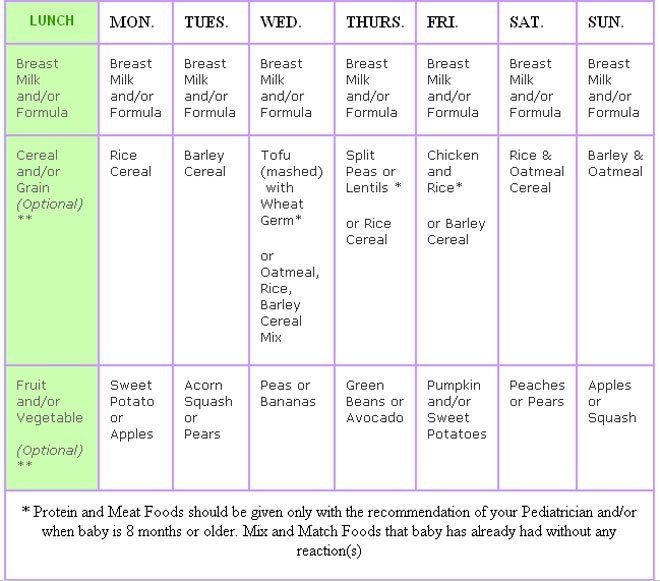 |
| Oatmeal | 6 Months of Later | Prepare with breastmilk or formula. Option to mix in yogurt, nut butter, mashed berries, or mashed banana. |
| Banana | 6 Months or Later | Mashed, mixed into sauces and purees, cut in halves or third-long pieces (BLW). |
| Sweet Potato | 6 Months or Later | Roasted or steamed so they’re soft enough to mash between your fingers. |
| Mango | 6 Months or Later | Cut into wedge-shaped pieces that baby can grip. Or, give baby the pit to work on! |
| Eggs (Common Allergen) | 6 Months or Earlier (If advised by a pediatrician or allergist) | Prepare eggs omelet-style and cut them into strips baby can grip. |
| Yogurt (Common Allergen) | 6 Months or Earlier (If advised by a pediatrician or allergist) | Serve yogurt as-is or mix it into sauces, oatmeals, or purees. |
| Nut Butter (Common Allergen) | 6 Months or Earlier (If advised by a pediatrician or allergist) | Mix nut butters into oatmeal or purees, or spread them thinly over toast. |
| Berries | 6 Months or Later | Mash berries into a thicker, jam-like consistency before serving. Consider mixing mashed berries into other foods. |
| Tofu (Common Allergen) | 6 Months or Earlier (If advised by a pediatrician or allergist) | Cut into thin strips that baby can grasp and fry them up in a pan. Serve cool or warm, not hot. |
| Broccoli | 6 Months or Later | Steamed or roasted so it’s soft enough to mash between your fingers. |
| Apple Sauce | 6 Months or Later | As-is or mixed in to oatmeal, yogurt, or purees. |
| Canned Sardines (Common Allergen) | 6 Months or Later | Whole piece or mashed with other foods. |
| Honey | 1 Year or Later | At 1 year or later, serve mixed-in to yogurt, sauces, or purees, or spread thinly on toast. |
| Fruit Juice | 1 year or Later | At 1 year or later, offer up to 4 oz per day. |
| Sugar | 2 Years or Later | Avoid added sugar before age two, then introduce it gradually and only as-needed. |
First Foods For Babies With Allergies
Food allergies have grown in prevalence over the last 50 years, and it’s now estimated that about 7% of babies have a food allergy! And while that can make choosing a baby’s first foods a little scary, the good news is that up to 80% of kids can grow out of their food allergies. (Especially when those allergies are milk and eggs!)
Important Information on Allergic Reactions & Introducing Allergens
For at least the last decade, parents were told to wait until 12 months or older to introduce the top eight allergens (peanut, tree nuts, eggs, milk, wheat, soy, fish, and shellfish) to their babies. Now, things are different. Today, we recommend introducing allergenic foods to your baby when they start solids, which, for most children, is around six months old. Introducing allergenic foods at this point in your baby’s development can reduce the risk of developing some food allergies—especially allergies to eggs and peanuts.
Introducing allergenic foods at this point in your baby’s development can reduce the risk of developing some food allergies—especially allergies to eggs and peanuts.
For Babies With Known Allergies
If your baby is already known to have a food allergy, do not introduce that food. But, if baby has certain risk factors WITHOUT a confirmed allergy (like eczema or a family member with a food allergy), consult the pediatrician. You may be referred to an allergist who will determine the best course of action with an introduction.
Introducing Allergens: What To Watch For
Mild allergic reactions may look like new hives around the mouth or face.
More severe reactions can include:
- Vomiting
- Lip Swelling
- Widespread Hives
- Face Or Tongue Swelling
- Difficulty Breathing
- Changes In Skin Color
- Sudden Lethargy Or Limpness
If you notice any of these severe signs, seek emergency medical help immediately.
Make Starting Solids Simple
I know that getting ready to start serving your baby their first foods is nerve-wracking. But with the right info (which you now have) and prep (which you’re equipped to do), I promise you it can be a great experience. Now that you know all the things about safety, allergic reactions, which foods to serve, and how to serve them, go in with your bases covered and just enjoy the time spent with your little one.
I also know that if you decide to go with solids, you might be a little extra nervous about things like gagging and making all foods baby-safe. And, I get it! These things can be intimidating the first few times. Lucky for you though, you’re not alone! You’ve got me in your corner. I’ve been there before, I’ve helped so many parents navigate through it, and I know you can do it, too.
To help you up your confidence, ditch the unnecessary doubts, and feed them well right from the start, I put together my research-backed Simply Solids guide.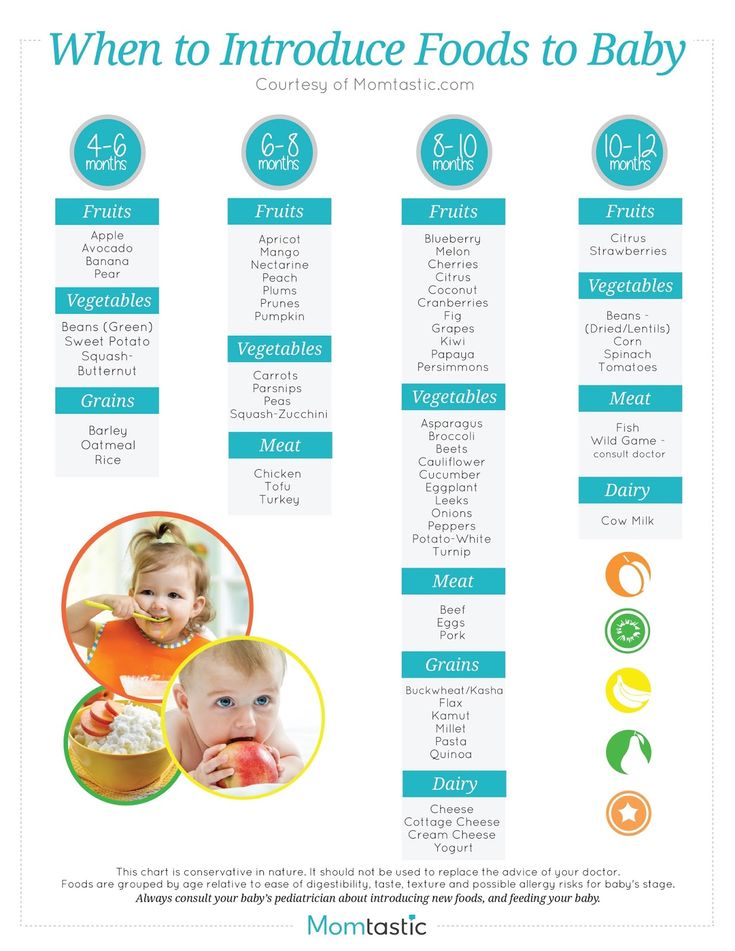 If you’re about to start—or already on—your baby-feeding journey, Simply Solids is a must-have.
If you’re about to start—or already on—your baby-feeding journey, Simply Solids is a must-have.
START THE CAR! Simply Solids Is Usually $15, But Right Now It’s Free
.Trust me, you’ll be kicking yourself if you don’t grab your copy right the heck now 👇
Get The Free Guide
Baby’s First Foods
Summary of baby first foods 4 to 6 months some ideas in case you want a printer friendly list!
No ratings yet
Print Recipe Pin RecipePrep Time 5 mins
Cook Time 5 mins
Total Time 10 mins
Course Breakfast, Dinner, lunch
Cuisine American
Servings 2 servings
Calories 50 kcal
- Avocado
- Oatmeal
- Banana
- Sweet Potato
- Mango
- Eggs (Common Allergen)
- Yogurt (Common Allergen)
- Nut Butter (Common Allergen)
- Berries
- Tofu (Common Allergen)
- Broccoli
- Apple Sauce
- Canned Sardines (Common Allergen)
Mashed, mixed-in to sauces or purees, or in wedge shapes baby can grip (BLW).
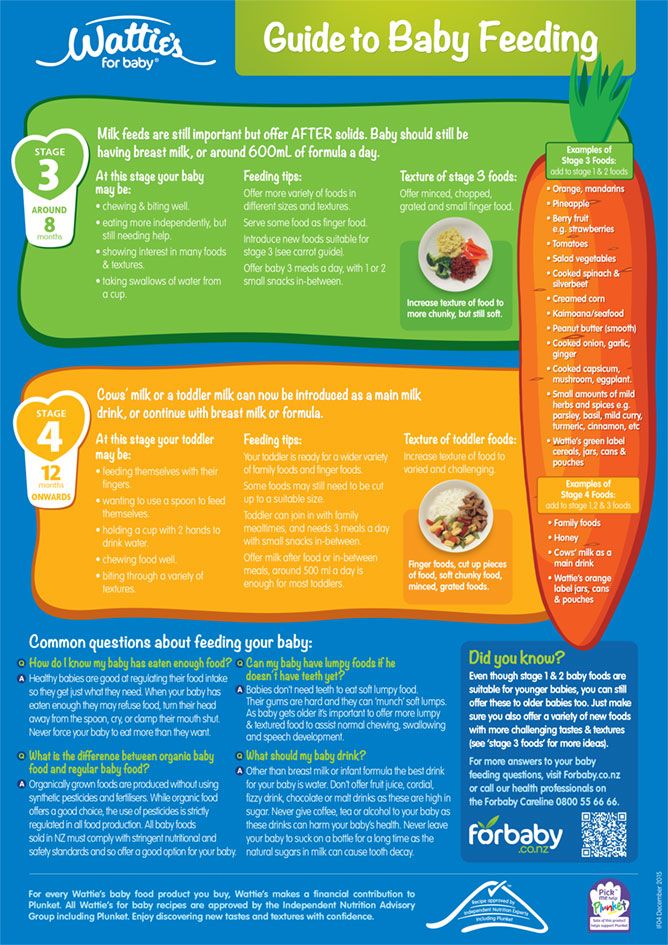
Prepare with breastmilk, formula, canned coconut milk or water. Option to mix in yogurt, nut butter, mashed berries, or mashed banana.
Mashed, mixed into sauces and purees, cut in halves or third-long pieces (BLW).
Roasted or steamed so they’re soft enough to mash between your fingers. Or, serve mashed with a spoon.
Cut into wedge-shaped pieces that baby can grip. Or, give baby the pit to work on!
Serve yogurt as-is or mix it into sauces, oatmeals, or purees.
Mix nut butters into oatmeal or purees, or spread them thinly over toast.
Mash berries into a thicker, jam-like consistency before serving.
Consider mixing mashed berries into other foods.
Cut into thin strips that baby can grasp and fry them up in a pan. Serve cool or warm, not hot.
As-is or mixed in to oatmeal, yogurt, or purees.
Calories: 50kcal
Keyword baby
Tried this recipe?Let me know how it was!
Baby's first foods: The 10 best foods for babies
These 10 first foods are ideal for your baby because they're full of essential nutrients, reasonably priced, easy to prepare, and delicious. Avocados contain healthy fats, while bananas are loaded with potassium. Blueberries are bursting with antioxidants, whereas broccoli offers fiber and folate. Both lentils and meat are packed with protein. Prunes can help with constipation, and yogurt helps form healthy bones and teeth.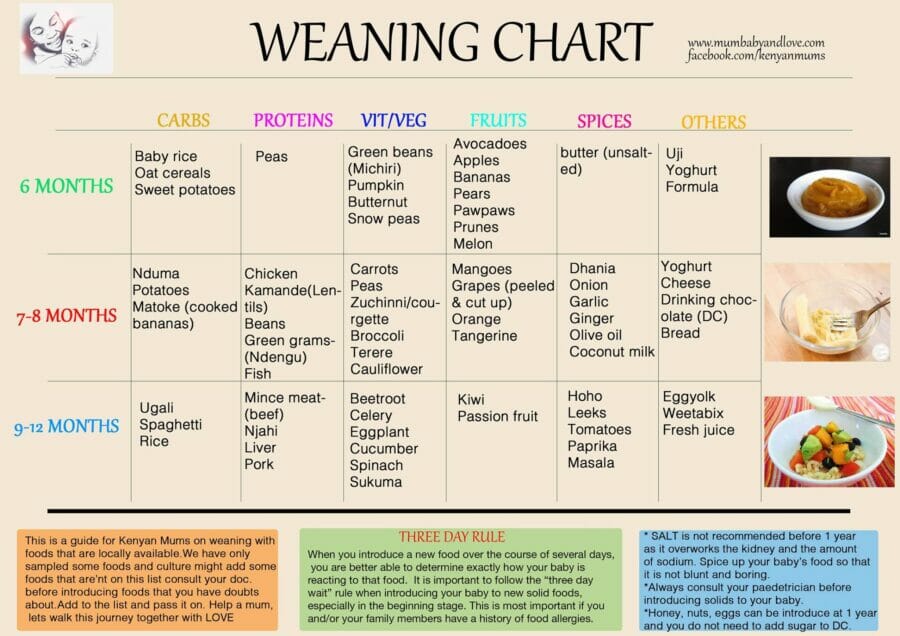 Sweet potatoes and winter squash are great sources of beta-carotene and vitamin C.
Sweet potatoes and winter squash are great sources of beta-carotene and vitamin C.
According to the American Academy of Pediatrics, it's important to offer your baby a variety of healthy foods. There are lots of healthy, baby-friendly foods out there, but these 10 recommended by doctors and dietitians alike stand out from the pack. From vitamin-rich fruits and veggies to meats and beans loaded with protein, these superfoods are full of essential nutrients, reasonably priced, easy to prepare, and delicious.
Many are also favorite first foods. Before introducing solids, talk to the doctor about your baby's readiness for solids, and which foods to introduce and when. Then introduce foods one at a time, waiting at least three days after each new food to watch for any allergic reaction.
Avocados
BabyCenter parents are all about avocado as a first food. This buttery fruit-vegetable is rich in healthy unsaturated fats that help boost brain development. In fact, the fat composition of avocados is somewhat similar to that of breast milk.
Serving ideas: Mash avocado with a fork, or make baby guacamole.
Bananas
Known as a good source of potassium, this grab-and-go fruit also contains vitamins B6 and C, fiber, and magnesium.
Serving ideas: Make banana and mango puree. Or, for your little one's first smoothie, puree banana and peach chunks with whole-milk yogurt.
Blueberries
Blueberries are bursting with antioxidants. The deep, brilliant blue of these berries comes from flavonoids that benefit your baby's eyes, brain, and even urinary tract.
Serving ideas: Blend or mash blueberries well and swirl a spoonful of the juicy purple puree into yogurt, or top silky coconut milk rice pudding with blueberry compote.
Broccoli
This cruciferous vegetable is a rich source of essential nutrients, including fiber, folate, and calcium. Introduce your baby to broccoli's bold flavor early, and you'll be expanding their tastes and encouraging a lifelong love of green vegetables.
Advertisement | page continues below
Serving idea: Steam until soft, cut into pieces small enough for your child to eat safely, and then chill. Steaming takes the bite out of broccoli, and some babies prefer the texture and taste when it's cold.
Lentils
Beans and other legumes pack lots of lean protein and fiber. But unlike larger beans, little lentils simmer into a pleasing mush just right for baby bites. They're also one of the cheapest healthy foods you can buy.
Serving ideas: Cook finely diced carrots along with the lentils. As your baby gets older, double up on nutrient-rich foods by making lentil and spinach stew.
Meat
Lack of iron can cause anemia. The American Academy of Pediatrics recommends meat as a first food because it's such a great source of protein, zinc, and iron, especially red meat and dark poultry meat. Plus, babies absorb iron more easily from meat than from iron-fortified cereals, another common first food.
Serving ideas: If your baby is new to solids, try our easy turkey or chicken puree recipe. As they get older, introduce new flavors with chicken curry with green beans and zucchini or shepherd's pie.
Prunes
Whether you call them "prunes" or "dried plums," these humble fruits don't sound glamorous – but they're soft, sweet, and full of fiber. Your baby may suffer from constipation when switching to solids, as it's a big change for their system. Add pureed prunes to your baby's diet to aid digestion and keep things moving.
Serving ideas: Serve pureed prunes alone or mixed with other foods, such as oatmeal, cereal, or applesauce, for a naturally sweet treat.
Sweet potatoes
Sweet potatoes are one of the more popular first foods for babies, who tend to like both their sweetness and texture. These colorful root vegetables are packed with beta-carotene, vitamin C, and minerals, including iron and copper.
Serving ideas: Serve sweet potato puree alone or swirled into pureed chicken or turkey.
Winter squash
Orange- or yellow-fleshed hard winter squashes such as butternut, acorn, and pumpkin boast many benefits, one of which is they're exceptionally rich in beta-carotene, recognized for being great for eyes. Squash is also an excellent source of vitamin C. Natural sweetness and a creamy texture add to the appeal of winter varieties.
Serving ideas: Roast a winter squash like butternut, scoop out the flesh, and puree it for an easy first food. As your baby gets older, introduce new flavors and textures with dishes like smashed chickpea and butternut chili.
Yogurt
Creamy yogurt is rich in calcium and vitamin D, necessary for healthy bones and teeth. Your baby can have it at 4 to 6 months, long before they'll be ready for cow's milk.
Opt for plain yogurt with no added sugar. Also look for a brand with the most live cultures, which help regulate the good bacteria in your baby's digestive tract. Make sure you pick up whole-milk yogurt – babies need the calories from fat.
Serving ideas: Yogurt is fine on its own, or swirl in pureed berries or other fresh fruit, applesauce, or mashed avocado.
Baby food: the best foods for babies | Types of products for children
Not all mothers and fathers know what applies to baby food and when they can be offered to the baby. In the practice of doctors, there are many cases when a baby of 3-4 months is already given cow's milk, and vice versa - at the age of 8-9 months, meat puree is still not introduced into the diet.
According to the WHO, it is recommended that complementary foods be introduced when the baby is 4-6 months old and should be done while breastfeeding continues. Complementary foods are understood to mean all liquid and solid foods that are offered to the baby - with the exception of breast milk itself and infant formula. In the Russian Federation, the introduction of complementary foods from 4-6 months is recommended. nine0003
In this article we will look at what kind of baby food is best for babies, what is recommended to use to expand the menu, how to choose and in what sequence to introduce foods into the diet of a child of the first year of life.
Choose foods for the first feeding
Kashi
Kashi is the best baby food for the first feeding of babies. They are made from cereals, contain a lot of carbohydrates, which give the baby energy for growth and development, and fiber, which contributes to comfortable digestion. This natural and healthy baby food is also a good source of vegetable proteins and fats. All Nestlé® baby cereals are additionally enriched with the Iron+ trace element complex, thanks to which the baby receives iron and other minerals from food. nine0003
Dairy-free, gluten-free, hypoallergenic cereals - buckwheat, corn - should become the first cereal-based baby products. Then the baby's diet can be expanded and other cereals can be introduced:
- Dairy cereals from gluten-free cereals - for example, buckwheat porridge with dried apricots, rice porridge with apple.
- Cereals from cereals containing gluten - oatmeal, wheat.
- Porridge from a mixture of cereals - multi-grain porridge with pear and peach, banana and strawberry pieces.
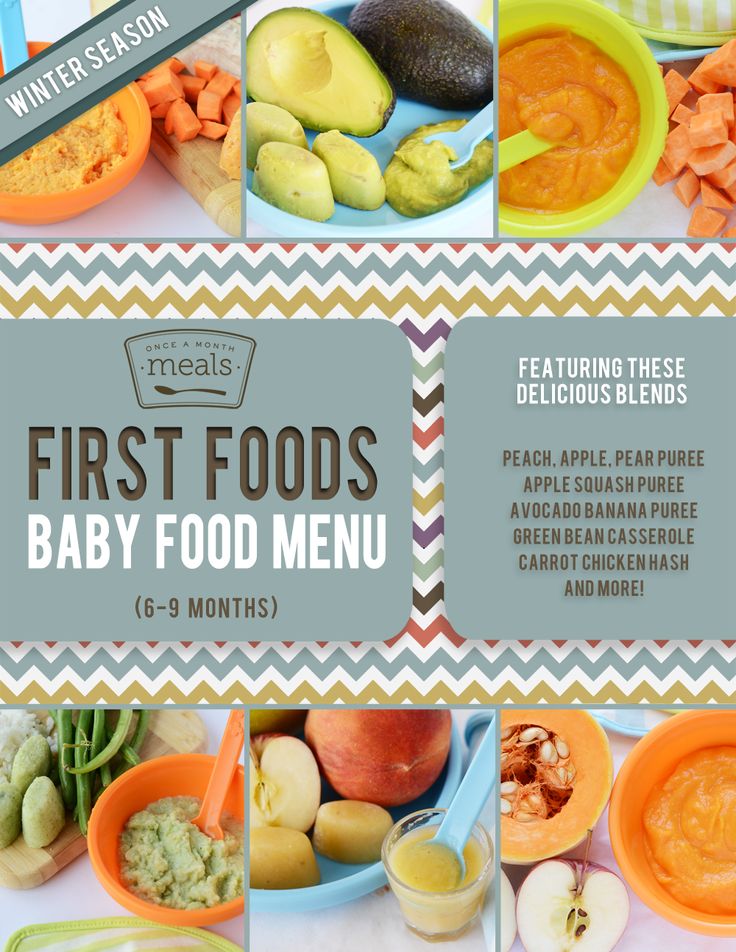 nine0023
nine0023 - Children's products containing milk in small quantities - such as industrial milk porridges.
- Special for children after one year.
- Fermented milk products - special adapted drinks.
- Low-fat cottage cheese.
- 1. National program for optimizing the feeding of children in the first year of life in the Russian Federation. Union of Pediatricians of Russia. Moscow 2019.
- 2. Feeding and nutrition of infants and young children. Guidelines for the WHO European Region with a special focus on the republics of the former Soviet Union.
- 3. Safina, A.I. Modern approaches to the nutrition of children from one year to three years old / A.I. Safina // Bulletin of modern clinical medicine. - 2016. - T. 9, issue. 2. - P. 77-85.
- 4. Infant and young child nutrition. WHO Newsletter.
- Obstetrician-gynecologist (Southern State Medical University, Faculty of Pediatrics, specialization at the Department of Obstetrics and Gynecology)
Nestle® Kashi is an easy-to-use dry baby food. Just take the right amount of porridge and dilute it with breast milk or water - it's very easy. You can prepare a very tiny portion, which is important when the baby first meets a new product.
Important!
Complementary foods always start with small portions. If your baby is trying porridge for the first time, offer him no more than one teaspoon. Watch out for reactions; if everything is in order - the next day increase the portion to two teaspoons. With good tolerance, gradually, within 5-7 days, bring the serving volume to the age norm. If, in response to the introduction of porridge, the child develops a rash on the skin, the nature of the stool changes, he becomes restless - do not give this product yet. It will be possible to try again to introduce it into the diet in a month. nine0003
Meat
Meat purees occupy a special place among baby foods. They are rich in protein, contain B vitamins, zinc, magnesium, and, most importantly, a lot of well-absorbed heme iron. By six months, the baby's iron stores are depleted, and a reliable source of this element should appear in his diet.
By six months, the baby's iron stores are depleted, and a reliable source of this element should appear in his diet.
Meat is introduced into the diet as homogenized baby food. It is recommended to start with mashed light white meat - rabbit or turkey - they have the highest iron content. Then the menu includes more nutrient-dense meats: veal and beef. nine0003
Vegetables
Vegetables contain carbohydrates, organic acids, fiber, pectin, various vitamins and minerals. Some of them, such as carrots and pumpkins, literally scream with their orange color about the large amount of beta-carotene, a provitamin from which the body produces vitamin A.
Puree is the ideal consistency for introducing crumbs to vegetables. Therefore, for children aged 4-6 months, all baby food should be homogenized. Pieces of food appear on the menu of the child closer to the year - and then very small. nine0003
For the first vegetable weaning, mashed marrows, broccoli, cauliflower are recommended. As your baby becomes familiar with simple foods, you can move on to purees with sophisticated flavor combinations, such as cauliflower and potatoes.
Note
There is a rule: one day - one new product. If you introduced mashed broccoli into your child's diet today, do not offer other new dishes yet.
Egg
Egg is not a first food product. Egg yolk can be included in baby food immediately after the first cereals and mashed potatoes, from 7 months. The yolks contain a lot of easily digestible proteins and fats, vitamin A and phosphorus. Choline is especially important - it favorably affects the development of the nervous system. nine0003
Fruits
Fruits are not only healthy, but also very tasty, because they contain a lot of natural sugars. They are also rich in vitamins and minerals, organic acids (citric, malic and others), fiber, which contributes to the comfortable functioning of the intestines. Baby fruit products are recommended to be introduced after the first feeding. It is better to start with fruits traditional for our country - apples or pears.
It is better to start with fruits traditional for our country - apples or pears.
Some mothers think that natural baby food from fruits can only be prepared at home. Actually it is not. Factory products - the best companies involved in the production of baby food, carefully test raw materials for the absence of heavy metals, traces of fertilizers and other harmful impurities, and are also responsible for the proportions of nutrients declared on the packaging. It is impossible to achieve this at home. nine0003
Fruit juices
Fruit juices are one of the popular liquid baby food options. They are similar in vitamin and mineral composition to fruit puree (especially juices with pulp) - they contain potassium, iron, vitamin C and many other useful substances. And, of course, juices are a pleasant delicacy that kids really like and greatly expands the palette of baby food flavors.
Juices are introduced into complementary foods simultaneously with fruit puree and according to the same scheme.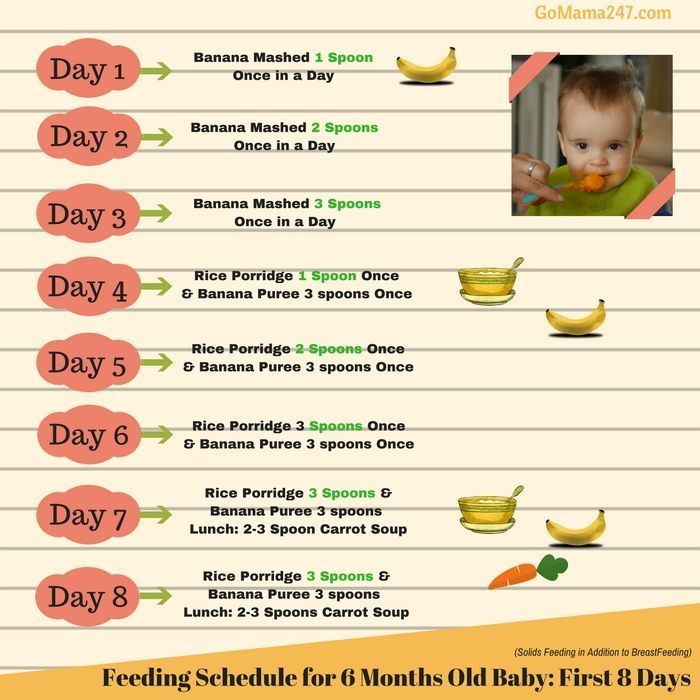 It is advisable to start with simple drinks from one fruit - for example, an apple or a pear, and only then indulge the crumbs with complex cocktails - such as a mixture of apple, grape and rosehip juices. nine0003
It is advisable to start with simple drinks from one fruit - for example, an apple or a pear, and only then indulge the crumbs with complex cocktails - such as a mixture of apple, grape and rosehip juices. nine0003
Fish
Like meat, fish in baby food will become a source of protein, B vitamins and other trace elements. In addition, it contains polyunsaturated fatty acids that are important for growth and development, which the child's body is not able to synthesize on its own in the right amount.
Babies can be offered fish from 8–9 months, replacing meat with it 1–2 times a week. When introducing fish, you need to remember that children have intolerance to this product. If fish feeding has led to allergies or other undesirable consequences, temporarily exclude fish from the diet and be sure to consult a specialist. It will help you choose the right foods for your baby. nine0003
Dairy products
Many parents in Russia believe that cow's milk is the best baby food, and this misconception is actively supported by the older generation.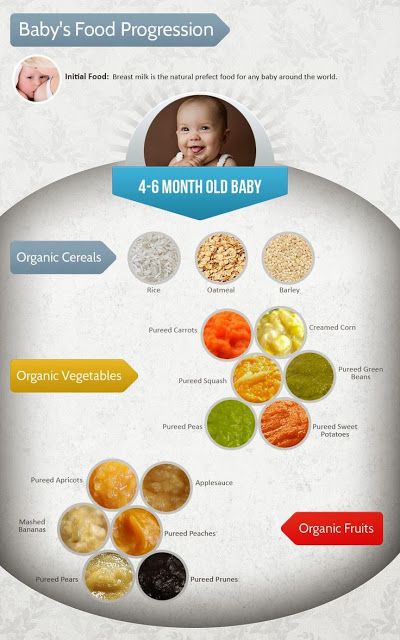 Don't believe it: whole cow's milk does more harm than good to babies and can cause digestive problems. In addition, milk contributes to too rapid weight gain, which in the future increases the risk of obesity, diabetes and other diseases.
Don't believe it: whole cow's milk does more harm than good to babies and can cause digestive problems. In addition, milk contributes to too rapid weight gain, which in the future increases the risk of obesity, diabetes and other diseases.
Instead of cow's milk, the following types of solid and liquid baby food are recommended for babies under 3 years of age:
Water
In the first months of life, the baby receives the necessary amount of water from breast milk. However, as an independent product, water appears in the baby's diet almost simultaneously with the first complementary foods. It is used for breeding dry baby food - dairy-free and milk porridges, as well as just for drinking. nine0003
The choice of water must be approached responsibly. Pediatricians recommend buying a baby special bottled water for baby food. It is manufactured in compliance with strict bacteriological standards, does not contain radioactive and harmful chemical impurities, and is characterized by low mineralization. For parents, this water is convenient because it does not need to be boiled - but only if used within a day after opening the package.
Pediatricians recommend buying a baby special bottled water for baby food. It is manufactured in compliance with strict bacteriological standards, does not contain radioactive and harmful chemical impurities, and is characterized by low mineralization. For parents, this water is convenient because it does not need to be boiled - but only if used within a day after opening the package.
Herbal teas
There are now quite a few herbal teas made specifically for baby food. They contain medicinal herbs and fruits - fennel, mint, anise, chamomile, rose hips, raspberries and others. nine0003
Sometimes berries, fruits, natural sugars are added to children's tea - this way the drink becomes more attractive for a little gourmet.
These children's products are a natural pharmacy that provides the baby with a complex of useful substances. However, some active components of herbal drinks can cause allergies, so teas should be introduced into the baby's diet with extreme caution.
Consult your paediatrician before starting complementary foods. A doctor who has been observing your child since birth will tell you what foods will benefit him, where to start getting acquainted with new dishes, and what points you should pay attention to. nine0003
Others articles by the author
From 4 to 6 months
Breast milk is the best food for your baby.
It is very important that the baby consumes breast milk for as long as possible.
Correct age to start weaning
Complementary foods are recommended to be introduced into the baby's diet no earlier than 4 months, but no later than 6 months*. At this age, the baby is in the active phase of development and reacts with curiosity to everything new! Some babies at 4 to 5 months of age can no longer satisfy their appetite with breast milk alone and need complementary foods for healthy growth. Other children have enough breast milk, and they are ready for the introduction of complementary foods only after 6 months. The decision to start complementary foods should always be made according to your baby's development. Do you feel like your baby is not getting enough breast milk? Does your baby hold his head on his own, show interest in new foods or a spoon? Then it's time to start feeding. If in doubt, consult your pediatrician. nine0003
If your baby spits out the first spoonfuls of puree, be patient. After all, he must first learn to swallow it. Start with a few scoops and give your child time to get used to the new form of feeding.
After all, he must first learn to swallow it. Start with a few scoops and give your child time to get used to the new form of feeding.
*Recommendation of the Nutrition Committee of the European Society of Pediatric Gastroenterology, Hepatology and Nutrition (ESPGHAN)
Why is complementary food important for the baby?
After 4-6 months of life, mother's milk or milk formula alone is not enough to supply the child's body with all the nutrients and necessary energy. In addition, the transition to solid food trains the muscles of the mouth. And finally, with the introduction of complementary foods, the child will get acquainted with the variety of taste directions, which is also important for his development. nine0003
When to start complementary foods?
Gradually replace one breastfeed with complementary foods. First for lunch, then for dinner and finally for lunch. The mouse eats breakfast with the usual dairy food.
Starting complementary foods with HiPP products is easy.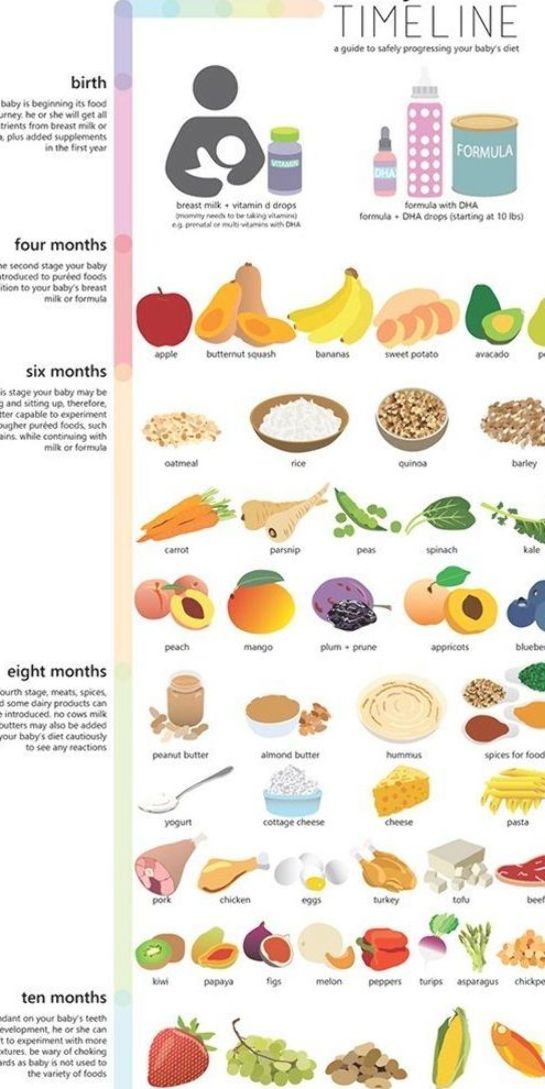 The first spoonfuls will be vegetable or fruit purees HiPP:
The first spoonfuls will be vegetable or fruit purees HiPP:
First step: lunch
We recommend that you start complementary foods at lunchtime with HiPP vegetable puree (for example, "Zucchini. My first puree", "Cauliflower. My first puree" or "Broccoli .My first puree"). Then, for satiety, feed your baby as always: breast or bottle. The amount of vegetable puree can be increased daily by 1 spoon. Be patient if your baby does not immediately love vegetables. Try repeating the vegetable puree in the following days. Next week, you can expand your diet with other varieties of HiPP vegetables (for example, "Carrots. My first puree" or "Potatoes. My first puree"). nine0003
If your baby tolerates vegetables well, in the third week you can introduce grain porridge into the diet, and as a dessert, offer a few spoons of fruit puree enriched with vitamin C. Vitamin C helps to better absorb iron in the body.
Once your baby starts eating a whole serving of mashed potatoes for lunch, you can eliminate breast milk or formula during that meal.


